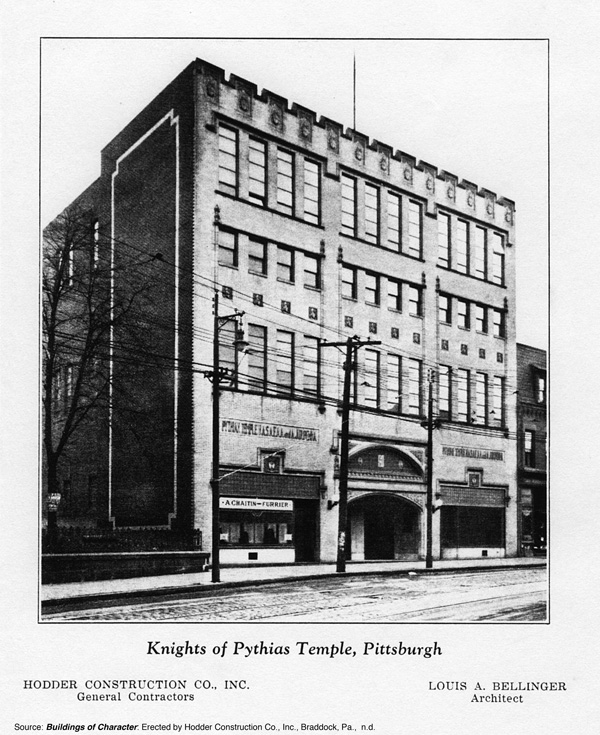
Architecture Feature: Louis Arnett Stuart Bellinger (1891-1946)
 Louis A. S. Bellinger was born in Sumter, South Carolina, on September 29, 1891. He was educated in mathematics and engineering at Howard University (B.S. in Architecture, 1914), then taught mathematics at Fessenden Academy, Ocala, Florida (1914-15), and at Allen University in Columbia, South Carolina (1916-18); he took a leave-of-absence to serve in World War I in 1917. In 1919 he and his wife Ethel Connel Bellinger arrived in Pittsburgh, where he is listed as an architect in the city directory. His first major commission was designing Central Park, home field of the African-American Pittsburgh Keystones baseball team in 1920, at the request of team owner, Alexander M. Williams. In 1922 he opened an office at 525 Fifth Avenue and advertised in the Classified Business Directory. Some Bellinger commissions were listed in the Western Pennsylvania construction magazine, The Builders’ Bulletin, beginning in 1922. He joined the office of the City Architect in 1923—the first African American to be hired—and as an assistant architect he designed a police station and remodeled service buildings in the city parks. In 1926 he received a major commission for the African Methodist Episcopal (A.M.E.) Book Concern in Philadelphia. A year later he won the commission to design the Pythian Temple in Pittsburgh for the African American Grand Lodge of the Knights of Pythias of North America, South America, Europe, Asia, Africa, and Australia, Jurisdiction of Pennsylvania. The lodge/commercial building at 2007-2013 Centre Avenue was completed in 1928 and was one of the largest and most prominent secular buildings in the predominately African American Hill District, known as Pittsburgh’s Harlem.[1]
Louis A. S. Bellinger was born in Sumter, South Carolina, on September 29, 1891. He was educated in mathematics and engineering at Howard University (B.S. in Architecture, 1914), then taught mathematics at Fessenden Academy, Ocala, Florida (1914-15), and at Allen University in Columbia, South Carolina (1916-18); he took a leave-of-absence to serve in World War I in 1917. In 1919 he and his wife Ethel Connel Bellinger arrived in Pittsburgh, where he is listed as an architect in the city directory. His first major commission was designing Central Park, home field of the African-American Pittsburgh Keystones baseball team in 1920, at the request of team owner, Alexander M. Williams. In 1922 he opened an office at 525 Fifth Avenue and advertised in the Classified Business Directory. Some Bellinger commissions were listed in the Western Pennsylvania construction magazine, The Builders’ Bulletin, beginning in 1922. He joined the office of the City Architect in 1923—the first African American to be hired—and as an assistant architect he designed a police station and remodeled service buildings in the city parks. In 1926 he received a major commission for the African Methodist Episcopal (A.M.E.) Book Concern in Philadelphia. A year later he won the commission to design the Pythian Temple in Pittsburgh for the African American Grand Lodge of the Knights of Pythias of North America, South America, Europe, Asia, Africa, and Australia, Jurisdiction of Pennsylvania. The lodge/commercial building at 2007-2013 Centre Avenue was completed in 1928 and was one of the largest and most prominent secular buildings in the predominately African American Hill District, known as Pittsburgh’s Harlem.[1]
Between 1927 and 1929 Bellinger posted current projects in the Pittsburgh Architectural Club/Pittsburgh Chapter A.I.A. journal, The Charette. (Unlike his white colleagues, however, his contributions were not acknowledged by the editor.) While the Pythian Temple was under construction, Bellinger was one of three black architects invited to participate in the first major exhibition of the work of African American artists in the United States, sponsored by the Harmon Foundation and held in New York City, January 5-15, 1928. In 1932 Bellinger designed Greenlee Field on Bedford Avenue in the Hill District for the Pittsburgh Crawfords baseball team. Greenlee Field, called the “finest independent ball park in the country, and one of the few black-controlled ones,” [2] opened on April 29, 1932. Later that year Bellinger became the first black candidate for Congress from the 32nd Congressional district; he lost the election. (An African American did not win a Congressional seat from Pennsylvania until 1958). In 1933 Bellinger was invited to contribute to the Harmon Foundation’s second African American art exhibition. Bellinger became the first African American hired as a City of Pittsburgh Building Inspector; he held this position from 1937-1939 and from 1941-1942. He practiced architecture briefly in 1940 and resumed his architectural career in 1943.
On February 3, 1946, Louis Bellinger died suddenly of a cerebral hemorrhage. He was 54 years old. He is buried in Allegheny Cemetery in Pittsburgh. The New Granada Theater, formerly the Pythian Temple, was placed on the National Register of Historic Places on December 27, 2010.
[1] In 1935 the Pythians defaulted on their mortgage payments, and although ownership of the Pythian Temple would not be resolved until 1948, the lodge lost control of the building in 1936. It was remodeled by Pittsburgh architect Alfred Marks as the New Granada Theater and opened May 20, 1937.
[2] Rob Ruck, Sandlot Seasons: Sport in Black Pittsburgh (Urbana: University of Illinois Press, 1987), 156.
